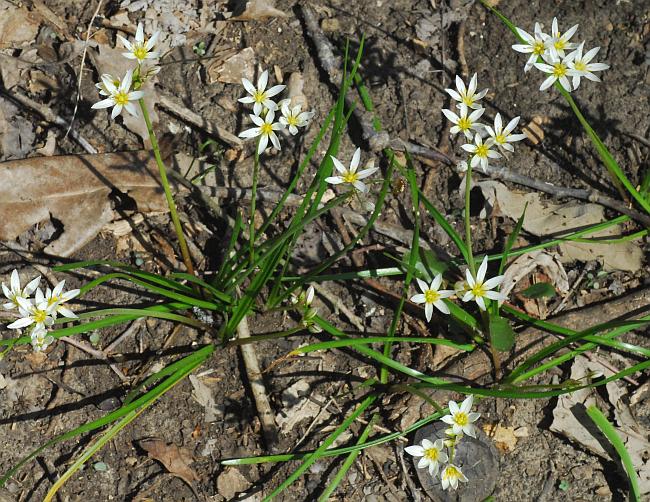Nothoscordum bivalve (L.) Britton
False Garlic

Native
CC = 4
CW = 3
MOC = 68
© SRTurner
Nothoscordum bivalve (L.) BrittonFalse Garlic | |
 |
Native CC = 4 CW = 3 MOC = 68 |
© SRTurner |
|
Family - Liliaceae Habit - Perennial forb, with bulbs covered with a membranous to papery, smooth, outer coat, lacking the odor of onion or garlic, glabrous. Stems - Erect, to 35 cm, 2-3 mm in diameter, unbranched, glabrous, hollow. Leaves - Basal, usually numbering 2-6, linear, flattened, glabrous, to 25 cm long, 3-4 mm broad.
Inflorescence - Terminal umbels of 3-11 flowers, subtended by 2 membranous, spathelike bracts. Flowers with stalks 20-50 mm long, none of them replaced by bulblets.
Flowers - Perianth 8-11 mm long, the 6 tepals free, broadly spreading, oblong-elliptic, white to light yellow, greenish at the base, sometimes with a purplish stripe on the outside surface. Stamens 6, fused to the base of the perianth. Style 1, glabrous, the stigma entire or shallowly 3-lobed. Ovary superior, with 3 locules, each with 3-10 ovules. Ovary superior, glabrous, with 3 locules, many seeded.
Fruits - Ellipsoid capsules. Flowering - March - May, sometimes again in October-November. Habitat - Glades, prairies, streambanks, upland forest openings, fields, prairies, roadsides. Origin - Native to U.S. Lookalikes - Species of Allium. Other info. - This tiny yet unmistakable lily is common throughout the southern 2/3 of Missouri, less common or absent in northern counties. It is also found across the southern half of the continental U.S. from Arizona to the Atlantic Coast, and southward into South America. Although resembling an allium, it has no garlic or onion odor whatsoever. Photographs taken off Highway 21, Chatham County, NC., 4-23-03, and off Lee Rd 54, Lee County, AL., 3-13-06 (DETenaglia); also at Young Conservation Area, Jefferson County, MO, 4-17-2013, and Matson Hill County Park, St. Charles County, MO, 4-14-2016 (SRTurner). |